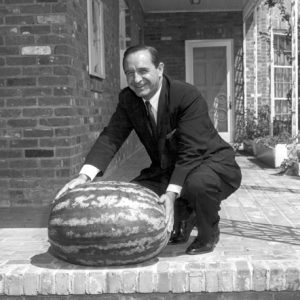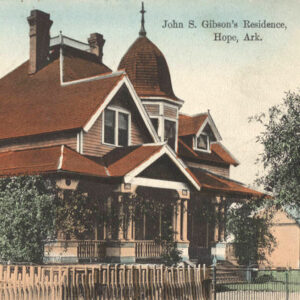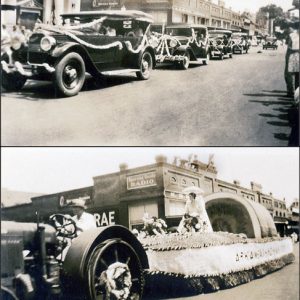calsfoundation@cals.org
Hope Watermelon Festival
Hope (Hempstead County) annually celebrates its claim as the home of the world’s largest watermelons with a yearly watermelon festival. The event first originated in 1926 and has been ongoing, though not continuous, since 1977. There is no admission fee for the multi-day event scheduled for the second week in August at Hope Fair Park. It is sponsored by the Hope–Hempstead County Chamber of Commerce. Activities include watermelon-eating and seed-spitting contests, fiddling, arm wrestling contests, as many as 200 vendors displaying their wares, and much more.
The competition for growing big melons was a creation of John S. Gibson, who, in 1916, began to offer modest prizes for the largest vegetables and watermelons. Hugh and Edgar Laseter, local farmers, developed a seed line to try to win the contest. Hugh grew Arkansas’s first giant watermelon in 1925. The 136-pound melon harvested on August 12, 1925, generated the excitement that led to the first watermelon festival, held the following year.
The first five festivals drew large crowds; for example, the crowd numbered 30,000 in 1928. Many visitors traveled on the Missouri-Pacific, Frisco, and Louisiana and Arkansas special trains from Little Rock (Pulaski County), Oklahoma, and Shreveport, Louisiana. Fox, Pathe, Paramount, and Metro-Goldwyn Mayer News filmed some of the events to show in theaters across the country, and loud speakers were borrowed from Arkansas Power and Light (AP&L) in Little Rock to broadcast the program to the large gathering of people.
Each year, the day’s program included a parade with decorated cars, floats, and bands. At Fair Park, a coronation ceremony including a pageant by local youth, introduction of the maids, and the crowning of a queen was followed by a speech by a visiting dignitary. Visitors then were served free iced watermelon. The day ended with dances in the Elks Hall, a skating rink, or in the streets. In 1928, two trains were stopped at noon so that passengers could be served ice-cold watermelons. The first queen was Laurine Lewis of Hope, who was chosen from the festival maids who were selected by vote from each political township.
Special speakers also attracted visitors to the festival. Tilman B. Parks, congressman of the Seventh Congressional District, crowned the first and second queens. The Democratic vice presidential candidate, Senator Joe T. Robinson, was guest speaker at the third festival in 1928, and he returned to speak and to crown the queen in 1930. Oklahoma governor William J. Holloway spoke in 1929, and Arkansas governor Harvey Parnell crowned the queen.
This ended the first series of festivals. In addition to the Depression, the handling of a “monster” crowd was too much for this small town. However, Oscar D. Middlebrooks briefly revived watermelon fever in Hope in September 1935, when the city learned of a giant melon in his field near Patmos (Hempstead County). His 195-pound watermelon was weighed on certified scales and photographed for the record. It was then shipped to movie star Dick Powell, an Arkansas native. President Calvin Cooledge and others have been recipients of the big melons.
In 1976, C. E. “Pod” Rogers Jr. convinced the Chamber of Commerce to sponsor the Watermelon Festival once more. Through the years, he had promoted Hope melons, taking samples to fairs and appearing on television programs. The 1977 festival and those since are different from the first five festivals because there is no pageantry—no parades, queens, or speeches, though the competitions, craft booths, and other forms of entertainment remain.
A notable champion melon, weighing 268.8 pounds, was cut from the vine on September 3, 2005, by Lloyd Bright. He grew it on his father Ivan’s farm east of Hope on the sandy ridge where many of the big melons have been grown. The family had raised notable melons from 1973, when a cousin was winner, to 1986, when Lloyd Bright’s son Jason had a 260-pound melon listed in the Guinness Book of Records. In his 1978 book Producing Giant Watermelons—An Arkansas Tradition, Lloyd Bright writes that anyone can grow the big melons with the proper knowledge and good seeds.
For additional information:
Bright, Lloyd. Producing Giant Watermelons—An Arkansas Tradition. Hope, AR: Etter Printing Company, 1978.
Hope Watermelon Festival. https://www.hopewatermelonfest.com/ (accessed July 27, 2023).
Leus, Christian. “Hope and the Watermelon: Dick Powell and the Seeds of Hollywood in 1930s Arkansas.” Arkansas Life, February 2019, pp. 30–35.
Mary Nell Turner
Hope, Arkansas
 Orval Faubus with Hope Melon
Orval Faubus with Hope Melon  Giant Watermelon
Giant Watermelon  Gibson Residence
Gibson Residence  Hope Watermelon Festival
Hope Watermelon Festival 




Comments
No comments on this entry yet.